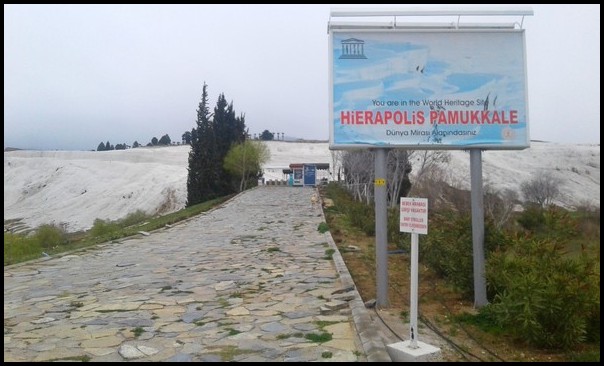
Amazing Pamukkale
One of Turkey’s Most Famous Sites
Pamukkale is a rather grubby hillside village located about 17 km / 10 miles north of Denizli, a large inland city in southwestern Turkey. Pamukkale’s small uninspired country houses are ill-kept, cluttered and are set in small messy plots.
Most residents keep a collection of farm animals: sheep, goats, cows, chickens and the inevitable guard dog. The animals all create more mess and infuse the whole village with the constant smell of animal shit.
Not a fresh fruit or vegetable can be bought in Pamukkale, despite the dozen or more small, family-owned convenience stores scattered about town. The shops all sell alcohol, snacks & drinks. You can at least buy bread and eggs, and a handful of small restaurants serve meals.
Needless to say, nobody would ever want to visit grubby little Pamukkale…except for one very special feature. Perhaps rather ironically, that striking feature makes Pamukkale one of Turkey’s top tourist destinations, famous among both Turks and international visitors.
It just so happens that Pamukkale lies at the base of a stunning geological anomaly. A humongous mass of chalk-white calcium has smeared itself over a huge hillside. Hot geothermal water seeps up over the calcium, running down the hillside in a huge series of terraced white-calcium pools filled with brilliant turquiose water. The affect is spectacular.
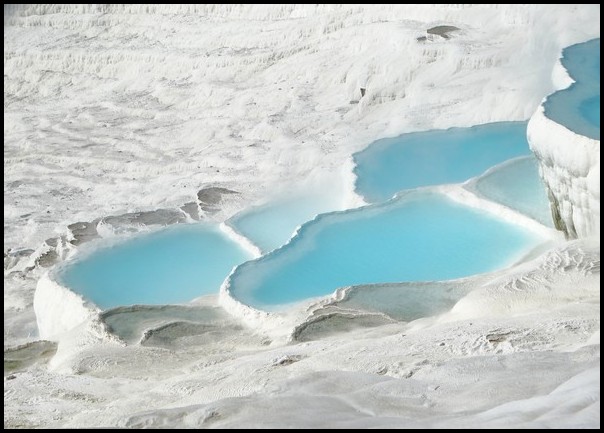
Viewing Pamukkale’s Geothermal Zone
There are three entrances to Pamukkale, two on the top of the formations and one at the base of the hillside, on the edge of the village. This allows visitors to view this massive calcium geothermal formation from below, above and from a distance at various vantage points.
On top of the vast formations, a wide walkway runs right along the edge for several km, providing ever-changing views of the calcium pools, water flows and stark-white slopes. The calcium formations are surprisingly diverse in textures and shapes. In cold weather, steam rises up from the hottest areas.
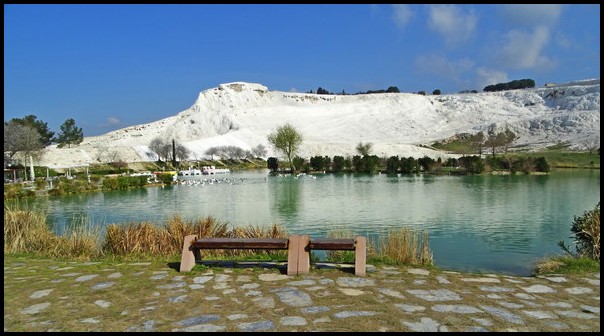
Between the bottom entry point and the top, people are allowed to walk around – barefoot only – on the huge calcium mass and right through many of the pools. That is an otherworldy experience and can be rather painful as the hardened, textured calcium can feel sharp on tender bare feet. If the weather is cold or hot, your feet will also become ‘frozen’ or ‘broiled’ on the exposed white slopes.
Pamukkale’s most spectacular feature of all are the tiered calcium pool filled with brilliant turquoise water.
At the base of the main calcium hillside, on the edge of Pamukkale village, there’s a green, leafy park with a large pond and a narrow calcium-tiered river flowing through. On one side of the massif, a wide waterfall trickles down the textured white calcium flow. And to one side, a small section of terraced pools provides a miniature version of the much larger terraced mass covering the hillside.
These spectacular terraced, geothermal pools alone make a trip to Pamukkale well worthwhile….But there’s more!
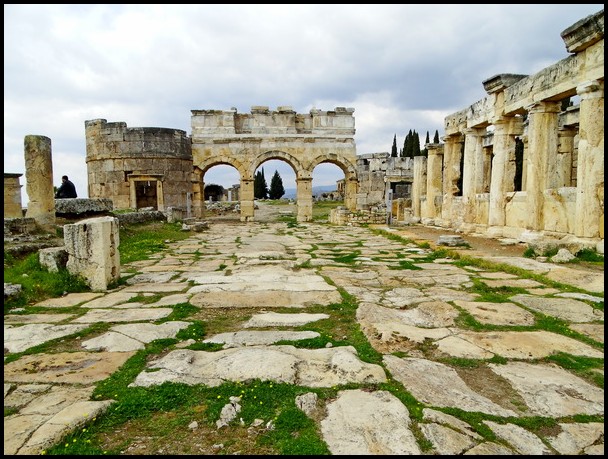
Hierapolis – Ancient Roman City
Scattered around a large plateau atop the huge calcium mass are the remains of an ancient Roman city called Hierapolis. Major sites include an amphitheater, a Roman bathhouse, an agora (government & public gathering center), a wide stone street lined by rows of tall marble columns, a large public toilet building and other building remains. A museum displays artifacts found at the vast archeaological site.
Back behind Hieropolis, there’s a large natural hot spring that people can get in for an extra fee. The hot springs are extremely popular, so it can become quite a zoo, especially in the high season months of July-September.

Karahayit – Red Springs
Karahayit, another village located just 7 km / 4 miles north of Pamukkale, is also worth visiting. Regular local buses run between the two towns.
Karahayit features smaller geothermal pools, called Red Springs, and an Ethnological Museum, with displays of local cultural.
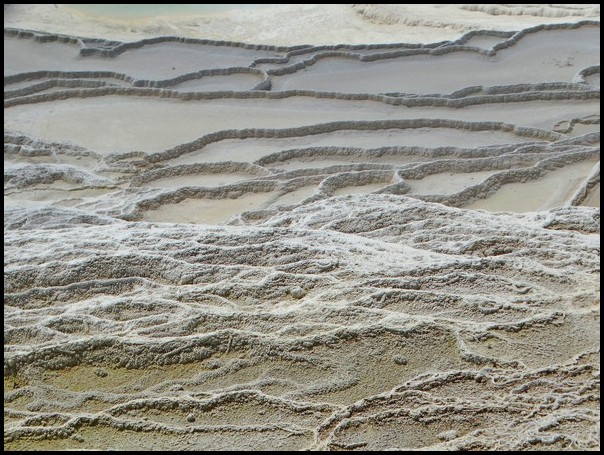
Visiting Pamukkale
Pamukkale is open year-round. Since it’s one of Turkey’s most famous & popular tourist destinations, lots and lots of group tours get carted there by bus to visit for a few hours.
That being the case, I strongly recommend visiting Pamukkale in off-season months, between November to May. In summer months the calcium fields and the hot springs become jam-packed with tourists. In addition, daily temperatures reach over 100F / 36C during July-September. Walking around in the completely exposed glaring-white calcium hills and Hierapolis ruins could become tortuous.
It’s easy to visit Pamukkale independently. Buses go there from most other cities in Turkey. Both Pamukkale and Karahayit towns have plenty of small, family-run hotels, and a handful of restaurants serve good food.
I recommend staying at least two full days to see all the sights. You’ll need one full day to wander around the vast geothermal calcium zone and Hierapolis. There’s also the lovely park & pond at the base of the white slopes. And a half-day to visit Karahayit would complete the explorations.
If at all possible, fit a visit to Pamukkale into your Turkey travels. It’s an amazing & unique natural wonder.
======================
You might also like:
My 10 Best Experiences on Turkey’s Turquoise Coast
==========================



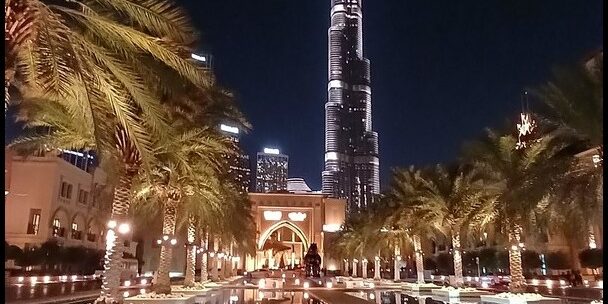




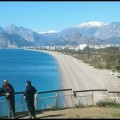



 Hi! I'm Lash, an American nomadic world traveler who's been traveling solo since 1998. I’m passionate about traveling the world nomadically and then sharing it all with you. I hope to inspire you to travel the world, to entertain you with tales from the road, and to help you reach your travel dreams. Welcome!
Hi! I'm Lash, an American nomadic world traveler who's been traveling solo since 1998. I’m passionate about traveling the world nomadically and then sharing it all with you. I hope to inspire you to travel the world, to entertain you with tales from the road, and to help you reach your travel dreams. Welcome! 



